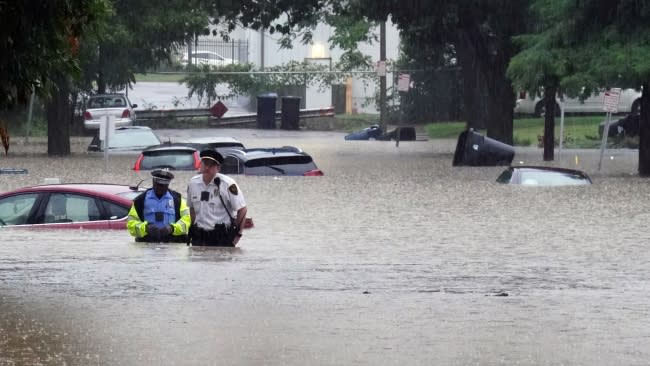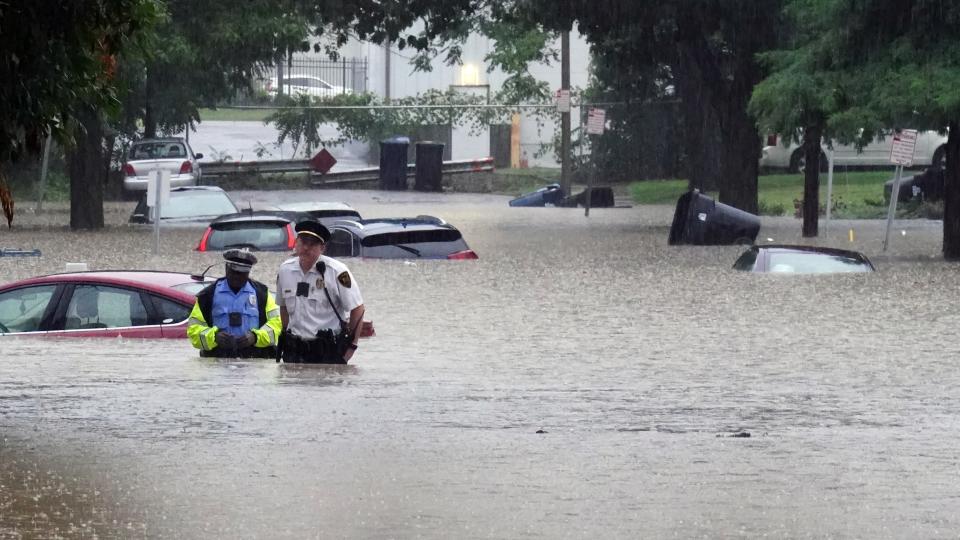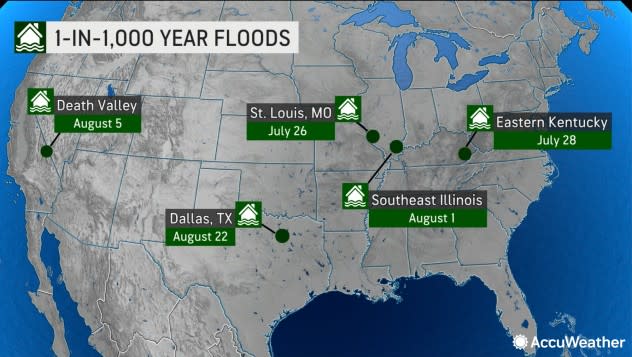Dallas flooding is 5th 1-in-1,000-year flood event in US since late July
In the last five weeks, five areas across the United States have all experienced what should have been very unlikely -- if not impossible -- one in 1,000-year flooding events.
The most recent historic flooding event occurred in Dallas on Monday, Aug. 22, where 8 to 16 inches of rain fell over a 24-hour stretch. The heavy rain flooded buildings, submerged cars on interstates and also caused the Trinity River to swell well beyond its normal water line. All of this resulted in billions of dollars worth of damage, according to an AccuWeather estimate.
AccuWeather Founder and CEO Dr. Joel N. Myers, who has for decades closely studied the economic impacts of extreme weather, estimated that the total damage and economic loss resulting from the catastrophic flash flooding would range between $4.5 billion and $6 billion.
This flooding occurred after a 67-day dry streak in the city, and according to Allen Li, a researcher at the University of Oklahoma, this weather whiplash is not only more common due to climate change but could happen again, even multiple times over the next 1,000 years.
"One in 1,000 [years] doesn't mean that only happened once over 1,000 years," Li told AccuWeather National Reporter Bill Wadell. It only means there's a 0.1 percent chance of it happening every year.
Another researcher used a gambling analogy to help understand how climate change makes these weather events happen more often.
"Imagine you're at a craps table, and you're throwing the dice and trying your luck," Rob Moore, a senior policy analyst at the National Resource Defense Council, an environmental advocacy group, told Wadell. "If the weather in that analogy are the dice, what climate change does is it loads those dice and makes events more likely, that in the past we would have considered unlikely if not impossible."
That means the record flooding events in St. Louis, eastern Kentucky, southeastern Illinois, Death Valley and Dallas, some of which have no precedent, are suddenly much more likely to occur, Moore said.
But the actual amount of rainfall in most parts of the country hasn't significantly increased over the last several hundred years, Moore said. So why are these massive deluges happening left and right?
"In the Midwest and Northeast, for example, climate change is not expected to dramatically alter the amount of rainfall we get in a given calendar year," Moore said. "But what it will do is it makes that rainfall come in a smaller number of more intense storms."
For parts of the southern and southwestern United States, what would normally be a small and consistent trickle of water over the course of the year, becomes a large bucket dumped all at once in a catastrophic storm.
On July 26, as much as 12 inches of rain fell over the St. Louis metro area, leading to swamped roadways, homes and businesses. Firefighters and emergency responders rescued hundreds, and the flooding claimed the life of at least one person. The event set an all-time record for rainfall in the area.
Days later, flash flooding in eastern Kentucky and southwestern Virginia caused mudslides, completely washing away homes and killing dozens of people. On Aug. 1, the town of Lincoln, Illinois, near Springfield, grappled with its own flooding after it received 8 to 12 inches of rain in about 12 hours. The flooding filled the streets with water and left cars fully submerged.
 |
Death Valley National Park in California received nearly a year's worth of rain on Aug. 5 when the weather station located in the park measured 1.46 inches of rain. The normal yearly rainfall total there is 1.90 inches. There were no reported fatalities, but about 60 cars were buried in debris caused by the flood and about 1,000 people were left stranded.
Moore said the amount of flooding and how it's happening all across the country is astounding.
"When I see storms, like the one in St. Louis, or those that are affecting eastern Kentucky, I'm always surprised because they are, in many cases, without precedent. But what we need to do is increasingly remember that these storms are now possible, and increasingly likely," Moore said. "So we need to rethink everything about how we build where we build, and the standards that we are designing and constructing homes, infrastructure -- really, everything in our community needs to be revisited."
Reporting by Bill Wadell.
Want next-level safety, ad-free? Unlock advanced, hyperlocal severe weather alerts when you subscribe to Premium+ on the AccuWeather app. AccuWeather Alerts™ are prompted by our expert meteorologists who monitor and analyze dangerous weather risks 24/7 to keep you and your family safer.



